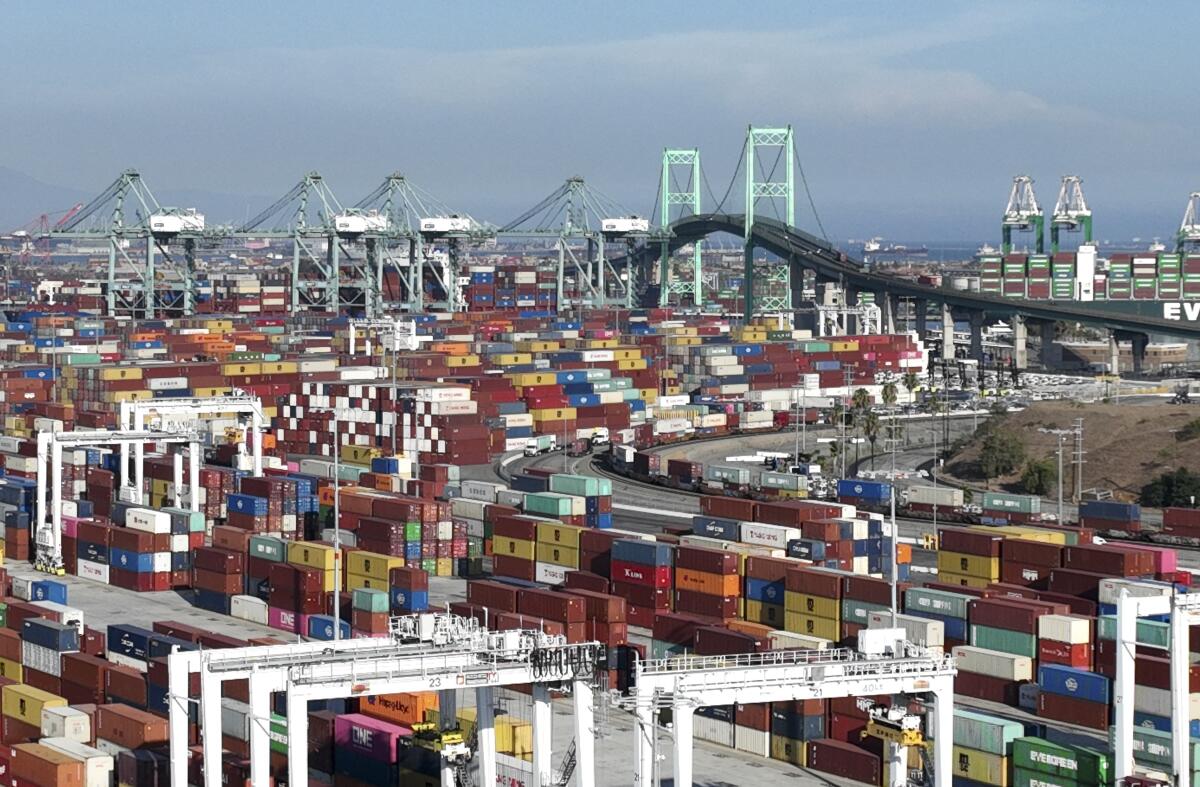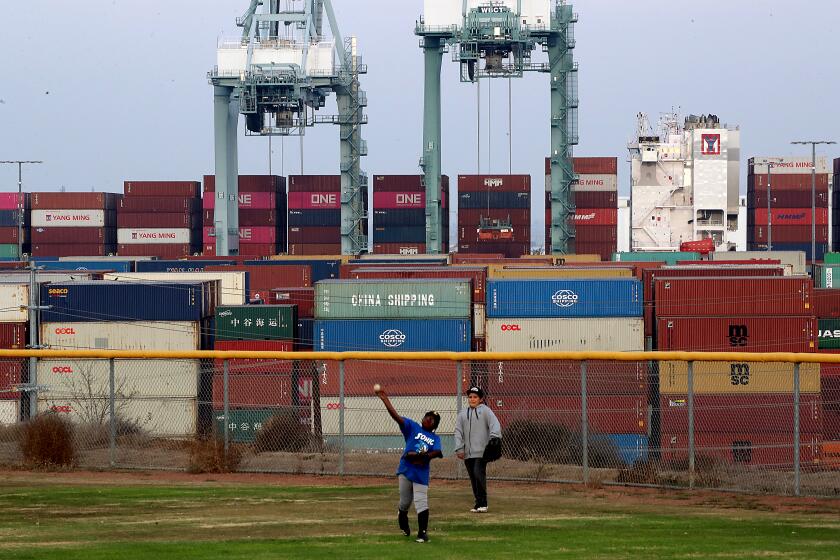L.A. ports can’t follow business as usual. Our shipping system is unsustainable

- Share via
Ports in the Los Angeles region entered national headlines as a supply chain crisis unfurled during the pandemic. After an initial near-halt to commerce and shipping in early 2020, some of us saw bluer skies and enjoyed cleaner air for a fleeting moment.
But by 2021, consumer purchasing skyrocketed and trade came roaring back. Though that might sound good for business, it’s a status quo in which the L.A.-Long Beach port complex is Southern California’s largest single source of pollution. If California wants to live up to its reputation as an environmental leader, port operations require more scrutiny — and change.
Though the ports were built to transport general goods and commodities, their fate has been particularly tied to fossil fuels. The rise of oil from the 1920s onward spurred their development to handle a large volume of petroleum. The wealth this generated was poured back into the ports themselves, intensifying the scale of trade. Combined, Los Angeles-Long Beach makes up the largest container port complex in the Western Hemisphere, through which goods — especially from Asia— reach warehouses, retail shelves, e-commerce fulfillment centers and ultimately consumers’ homes.
Officials at the ports of Los Angeles and Long Beach recorded an unprecedented surge in harmful emissions during 2021. They blame COVID-19.
The pandemic dramatically illustrated the scope of this economic engine. A spike in consumer demand coincided with labor interruptions and other snarls to supply chains, exemplified by the logjam off the coast of Southern California where dozens of ships queued waiting to dock. Residents, especially those living near the ports and distribution corridors, breathed in sharply elevated air pollution.
To preempt future disruptions, state and local officials and the Biden administration have moved to streamline and expand goods-handling in the last couple years. Biden announced that hours of port operation would be extended to keep cargo movement humming. The Port of Long Beach unveiled a new bridge built to allow larger ships’ passage (even as seas rise), and it received federal authorization to deepen its shipping channels. Local officials now fret about whether ports on the East Coast and the Gulf of Mexico will snatch away a significant share of cargo business because of disruptions in Southern California.
Economic concerns are understandable, especially since the ports are associated with thousands of jobs. But building bigger operations to move an ever-increasing volume of goods is short-sighted locally and globally. Massive ships create infrastructure demands at odds with our need to reduce carbon emissions, curb resource extraction and control environmental pollutants. Many shipped consumer goods are bound for landfills after only a very short period of use. Apparel, appliances, electronics and furniture have shorter lifespans than they did a few decades ago. The way we consume goods right now is simply not sustainable.
Meanwhile, officials and regulators have been sharply criticized for delaying measures to safeguard health for communities around the ports. As air quality activists note, cutting port emissions is urgently needed. Electrifying port and warehouse equipment is underway, but long-haul journeys, including ocean shipping itself and truck distribution, also need to transition off fossil fuel — cargo ship fuel is even dirtier than the diesel on which trucks run — and meet much lower emissions targets. San Pedro Bay’s port complex also traffics a large volume of fossil fuels in addition to consumer goods. Petroleum handling in the ports will need to be significantly diminished to meet the challenge of climate change.
Editorial: Port pollution is a crisis. It’s going to take more than a $20 container fee to fix
Air pollution at the ports of L.A. and Long Beach surged dramatically during the pandemic. To fix this, city and port officials need to act fast.
The ports play a substantial role in the interlocking crises in our region, which require an expansive vision. After decades of improvement, air pollution is rising again, due to not only transportation and industrial emissions but also to bigger wildfires, which are the result of rising temperatures. Global shipping at scale also contributes to the erosion of Indigenous sovereignty by encouraging extractive practices that degrade land, which in turn drives global warming and a related biodiversity and extinction crisis.
How California tackles these threats will have effects far beyond our state. Gov. Gavin Newsom’s “30x30” plan — which made California the first state to commit to conserving 30% of its land by 2030 — will provide wildlife habitat that can help absorb carbon. Yet conservation cannot absolve California of its lethal industrial areas. We must approach even freight corridors as spaces for people and nature rather than “sacrifice zones” where toxic exposure is accepted as necessary for industrial activity.
As Angelenos, we should be planning for a future where the success of the ports and the region is not measured by year-over-year growth in goods movement. Indeed, a more livable future in this region might see the ports planning for fewer ships and fewer goods, handled more slowly and accompanied by good jobs in cleaner energy, environmental stewardship and remediation of contaminated sites.
A just energy transition will require that we examine every part of business as usual. That means reconsidering how we’ve managed the ports for the past century. We should be reimagining their role in a more democratic, far less fossil-fuel-dependent future.
Christina Dunbar-Hester is a communication professor at the Annenberg School for Communication and Journalism at USC, a current member of the Institute for Advanced Study and the author of “Oil Beach.”
More to Read
A cure for the common opinion
Get thought-provoking perspectives with our weekly newsletter.
You may occasionally receive promotional content from the Los Angeles Times.











